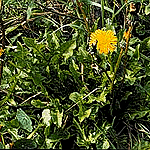|
|
The Eclectic Physician
Medicinal Herb Monographs
Dandelion
Botanical Name
Taraxacum officinale
|

Taraxacum officinale
(Dandelion)
|
The information on this page compiled by
Beth Burch N.D.
Index
(click on the keywords)
Introduction
Taraxacum is known throughout the world and has a long history of use as
both food and medicine. The botanical name Taraxacum is from the Greek,
taraxos (disorder) and achos (remedy). The common name Dandelion, comes
from the French, Dent-de-lion, or teeth of the lion, referring to the tooth-like
edges of the leaves. KIngís American Dispensatory reports its long use
in the treatment of disorders of the liver and gallbladder, as well as
its diuretic action useful in edema, and mild laxative action in constipation.
Dandelion is high in potassium making it useful as a potassium sparing
diuretic. Weiss notes its use as a cleansing spring tonic, nutritious and
stimulating to the liver and kidneys. Weiss also reports the use of dandelion
in the prevention and treatment of gallbladder disease. Modern research
has confirmed Dandelionís ability to enhance the flow of bile and its strong
diuretic action.
[ Back to the Index. ]
Description
-
Taraxacum is found worldwide, frequenting fields, gardens and yards. A
perennial plant, it flowers from April to November. The dark green, hairless,
toothed leaves have prominent veins and grow directly from the tap root,
as does the hollow flower stalk. The flower is bright yellow. What appear
to be petals are actually individual flowers, a characteristic of the compositae
family that Dandelion is a member of. Each of the little flowers forms
a seed with fluffy bristles allowing the seed to float in the wind to be
scattered. The tap root is yellowish or brown and fleshy. The whole plant
has a milky white juice and a bitter taste that becomes stronger with age.
All parts of the plant are used.
[ Back to the Index. ]
Constituents
-
Sesquiterpene lactones
-
Triterpenes and sterols including taroxol, taraxerol and B-sitosterol
-
Phenolic acids including caffeic acid
-
Flavonoids
-
Polysaccharides including glucans, mannans and inulin
-
Carotenoids (higher than carrots)- ~14000 IU per 100 grams
-
Protein
-
Sugar
-
Pectin
-
Choline
-
Potassium- up to 5%
[ Back to the Index. ]
Action/Effects
-
Diuretic- leaf has stronger effect (1)
-
Cholegogue (stimulates bile flow) (3)
-
Laxative (2)
-
Digestive bitter (2)
[ Back to the Index. ];
Conditions used
for
-
Edema, water retention (1)
-
Constipation (2)
-
Digestive disturbances including dyspepsia and loss of appetite (2,3)
[ Back to the Index. ]
Dosage
-
Liquid extract- 1-2 teaspoons three times a day
-
Freeze-dried or dried- 300-450 mg three times a day
-
Fresh plant juice- 1 tablespoon twice a day
[ Back to the Index. ]
Food Use
-
Young dandelion leaves make an excellent spring green. When young and tender,
they are delicious fresh in a salad. In fact, there are cultivated varieties
of dandelion sold specifically as greens.
-
Dandelion wine is made from the flowers allowed to ferment with sugar and
yeast. An aperitif can be made with the flowers, sugar and vodka for a
nice digestive stimulant.
-
Dandelion root can be dried and roasted to be used as a coffee substitute.
[ Back to the Index. ]
Side Effects
-
May cause loose stool in large doses.
[ Back to the Index. ]
Contraindications
-
Peptic ulcer or gastritis
-
Diarrhea
-
Gallstones
-
Acute inflammation of gastrointestinal tract or gallbladder
-
Allergy to dandelion or related plants
-
Psoriasis
[ Back to the Index. ]
Interactions
with medications
-
Do not use with other diuretics
-
May interfere with the action of medications that are metabolized in the
liver.
[ Back to the Index. ]
Use
in pregnancy & lactation
-
Safe for use in pregnancy and lactation
[ Back to the Index. ]
References
1. Racz-Kotilla E et al, The action of Taraxacum officinale
extracts on body weight and diuresis of laboratory animals, Planta Med
1974; 26:212-17
2. Kuusi T et al, The bitterness properties of dandelion, Lebensm-Wiss
Tachnol 1985;18:347-49
3. Buhm K, Choleretic action of some medicinal plants, Arzneim-Forsch
Drug Res 1959;9:376-78
[ Back to the Index. ]
* The information presented in this web site is intended to inform and educate.
It is not intended replace a qualified medical practitioner to diagnose or treat medical conditions.
|
|

